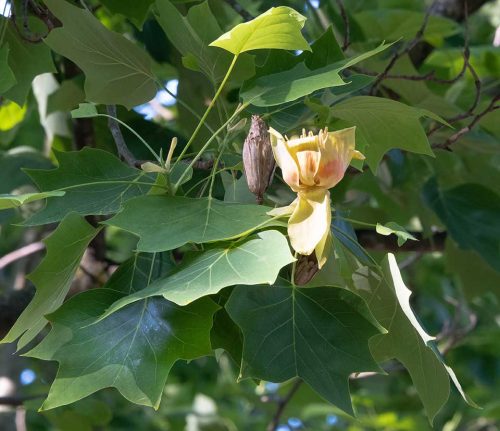Towering Sentinel
The fast-growing tulip poplar easily dwarfs neighboring structures as it provides a shady retreat.


Watching over one of Millville’s hubs of creative undertakings is a stately sentinel; its imposing presence is familiar to all who visit. In May it blossoms with greenish-yellow and orange epaulets that command one’s attention. Its impressive 100-foot height and 75-foot spread has it towering over the hill upon which it sprouted as a sapling. It dwarfs the Barn Studio that houses the Maurice River School of Art and its students. The hill is part of land owned by artist laureate Pat Witt, who welcomes all who visit. However, when it comes to protecting the tuliptree her rule is a steadfast “Look but don’t touch.” She would probably be the first to tell you that you really can’t own a tree, you can only appreciate it.
Whenever I have attended Barn Day in the spring, invariably one of the young art students will warn me to keep a safe distance from the tree. I know exactly where this respect comes from, and I smile at the mental image of Pat teaching the young aspiring artists a lifelong veneration for trees.

The tuliptree’s scientific appellation is Liriodendron tulipifera, but its common names are many: tuliptree, tulip poplar, tulip magnolia, whitewood, yellow poplar, and canoewood. It is native to the eastern third of North America and is New Jersey’s tallest and likely fastest-growing tree, reaching heights of 200 feet although more commonly closer to 100 feet. In fact I often tell people in their 50s and older that if they want to see a sapling reach tree status, they ought to plant a tulip poplar.
The leaves of this deciduous tree are distributed alternately on the branch, as opposed to opposite one another. Each is squarely shaped with two to four lobes, shiny dark green on the upper side and a dull, lighter green beneath. In fall the leaves turn yellow. Together its broad leaves cast a massive swath of shade beneath its often immense presence.
It grows extensively along the slopes of waterways. Its roots seek moisture but it thrives best in moist drained soils within mixed woodland. If you want to see some massive stands of tulip poplar, visit Susquehanna State Park near Havre de Grace, Maryland, where the 120-feet-plus straight trunks masterfully line many roadways and extend into the forest.
I was prompted to write about our subject because currently the river is lined with poplars in full bloom, and many of them are great specimens that tower over the shorelines. The name tuliptree derives from the fact that the flowers are tulip-like in appearance. The fruit is a samara, or winged seed. These are held together in clusters that resemble a cone. The samara often stays on the tree through the winter, persisting into late spring. These upright features make the tree identifiable in winter. While the seeds are how the tree propagates, they are often not fertile.

The tree’s straight trunk has made it especially useful in construction. The native Cherokee used the wood for canoes and medicinal purposes. Miners secured mine shafts with tulip poplar timbers. Today it is still valued for furniture because it has a fine grain and is a stable hardwood. Its coloration is variable, including cream, yellow, green, brown, and even purple hues, such that when staining, uniformity is difficult to achieve. Therefore it is primarily utilized in portions of the furniture that are not displayed—drawer liners, hidden casework, or painted pieces. However choice pieces have been used for veneers. Its pulpwood is also processed for paper production.
As you may recall, each butterfly and moth has evolved to be reliant on optimal food sources called host plants. The tuliptree is a host plant for the following moths: Tulip-Tree Beauty, Polyphemus, Promethea, and Sweetbay Silkmoth. The larvae of all of these species are sizable. It is best known as a host plant for the beloved Tiger Swallowtail, a large, showy yellow butterfly.
Native American uses for Liriodendron tulipifera ranged from making 30- to 40-foot canoes to cribs and medical treatments. Cherokees made an infusion with bark that was taken for pinworms and cholera infantum, a gastroenteritis in children that is often fatal. Cough syrup was made from the bark. It was further used as a dermatological aid for wounds and for control of fever. It was given as a sedative for women with “hysterics and weakness.” Bruised bound leaves were bundled around the head of nerve pain sufferers. A tincture for snake bites has also been attributed to the tuliptree. Cherokee used it in the making of honey, as do people even today.
Modern research is exploring essential oils obtained from the tuliptree for properties that may help combat brain tumors and malignant melanoma.
 Back to the Barn Studio, on one particular Barn Day I envisioned draping a clothesline around the tuliptree in order to hang children’s art works with clothespins. A young student came up to me and warned me not to implement my plan.
Back to the Barn Studio, on one particular Barn Day I envisioned draping a clothesline around the tuliptree in order to hang children’s art works with clothespins. A young student came up to me and warned me not to implement my plan.
“That’s a magic tree, and you can’t do that or Ms. Pat will be very upset.”
On reflection I think the child was correct: Tuliptrees are magical and I suggest you go outside and experience its marvels and grandeur for yourself.
Sources
Simon & Schuster’s Guide to Trees
Trees of New Jersey and the Mid-Atlantic States, New Jersey Department of Environmental Protection, Division of Parks and Forestry
Caterpillars of Eastern North America, David L. Wagner
Quassinti L, Maggi F, Ortolani F et al. Exploring new applications of tulip tree (Liriodendron tulipifera L.): leaf essential oil as apoptotic agent for human glioblastoma. Environ Sci Pollut Res Int. 2019 Oct;26(29):30485-30497. doi: 10.1007/s11356-019-06217-4. Epub 2019 Aug 23. PMID: 31444719.
WoodMagazine.com








